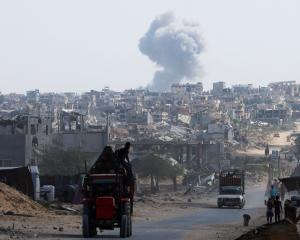
Through the day and night, with occasional rests in paddocks, the men of the Otago Battalion headed back to battle.
The Otago 1st Battalion marched for 27 hours and, remarkably, not a single soldier fell out, which regimental historian Arthur Byrne thought might have been a record for the New Zealand Division. The 2nd Battalion’s rushed journey to the front was no less arduous and if the men had the relative comfort of being on the backs of trucks for a while, they had the discomfort of spending a night in the cool open air.
The Germans wanted to split the British and French armies and take the strategically placed city of Amiens, an important railhead in the Allies’ supply lines. For a time, as a mass of artillery fire rained down on British and French positions, the position seemed desperate. In some places, the British had to fall back, creating gaps in the defences. New Zealanders and Australians were ordered back into the line to plug gaps and to hold positions. In some cases, they were back in Somme positions where they had fought so desperately two years before.
But as desperate as the times were, war correspondents wrote of the rush to the front as if the soldiers were off to a football match.
"The Australians and New Zealanders have come into the line, fresh and keen, uplifted by a fierce enthusiasm, stirred by emotions which make these fellows very dangerous."

The New Zealanders followed the Australians "spick and span, debonair lads who have already seen many adventures. It was a glorious night on the road".
Dunedin-born Malcolm Ross, the New Zealand correspondent who had been with the troops since Gallipoli, was a little more circumspect, although he did say that when they heard they were being rushed to the front, they cheered.
"The men look well," he wrote, "are keen, and in good form and spirits, though rather tired with marching. They look forward to some good shooting amongst the oncoming masses of Germans."
It wasn’t just soldiers on the crowded roads which in some places were nothing more than rutted, muddy tracks. They passed at one stage an old man driving a cart, in which there was a calf and an old woman. Tied to the tail of the cart was a cow, and tied to the tail of the cow was the family dog.
"All were marching slowly in line of the guns and lorries in limbered wagons. Never before in the war have the New Zealanders seen anything like it," Ross wrote.
The soldiers also entered a war of movement, in contrast to the trench warfare of the first three years on the Western Front, after the front line had been established from the sea to the Alps. Now, the fighting was in open country and accompanied by rapid movement. It was a novelty for all, including the New Zealanders.
"I may mention that this morning, on going out to the front with staff officers," Ross wrote, "we almost drove our motor car into our artillery barrage that barred the way to the village we were making for. We turned into an open field, and reached the village by another road just as two shells burst right in the centre of it."
Fighting was as deadly as ever, but the New Zealanders appeared to have approached their latest task in a lighter mood. Military niceties went by the board and men dressed in whatever took their fancy, or whatever they could get. Some wore German overcoats they’d salvaged from the battlefield, and some even wore civilian corduroy.
"One humourist, a gunner clad in khaki but wearing a tall silk hat, was unloading ammunition, apparently unconscious of the amusement he was creating," Ross wrote.
He saw the reality behind the fun: "It will be seen that fun and the spirit of novel adventure which are the characteristics of our men provide an appropriate light to the shade of grim tragedy that is inseparable from any battlefield."
That was a familiar concept to Ross because two years before, with son Noel, he wrote a book called Light and Shade In War, a collection of short essays on various aspects of the war.
When the Otago soldiers occupied old trenches which had been used by the British just before the opening of the Somme battle in 1916, sentries had to stand at their posts for two and sometimes four hours during the night thigh-deep in mud and water "and when relieved, indifferent to all else but sleep, crawled exhausted into filthy, shallow holes scooped out of the slime of the parapet," the Otago history said.
Men wrapped in old bags or blankets or dead Germans’ groundsheets more resembled beasts than human beings, it said.
It was during this stemming of the German spring tide that Brigadier-general Harry Fulton, of the well-regarded Dunedin family, and Major Bob Purdy were killed when the Rifle Brigade headquarters was shelled. Fourteen were in the cellar used as a headquarters — only four survived.
During the three-week period, about 500 men of the division were killed, indication in itself that while it may have represented a new type of warfare, the costs were just as severe. The period was deemed a success though, New Zealanders given credit for the saving of Amiens and for holding the line against a determined German attack.
Operation Michael was not the last German offensive of the war but it was a critical one and its outcome left its effect on what was to follow. Further efforts by Germany to regain lost ground and impetus came in June and July, when old ground at Messines and Passchendaele was again fought over, but for the Germans, time and materials were running out.










